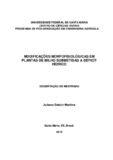| dc.creator | Martins, Juliano Dalcin | |
| dc.date.accessioned | 2010-08-13 | |
| dc.date.available | 2010-08-13 | |
| dc.date.issued | 2010-03-01 | |
| dc.identifier.citation | MARTINS, Juliano Dalcin. MORPHOPHYSIOLOGICAL CHANGES IN MAIZE PLANTS SUBMITTED TO WATER DEFICIT. 2010. 102 f. Dissertação (Mestrado em Engenharia Agrícola) - Universidade Federal de Santa Maria, Santa Maria, 2010. | por |
| dc.identifier.uri | http://repositorio.ufsm.br/handle/1/7529 | |
| dc.description.abstract | The use of no tillage can be an important technology to minimize the effects of the water deficit, for providing more water to the plants according to the maintenance of crop residues the soil surface. This technique reduces the amount of water evaporation from the soil, keeping it more humid, reducing fluctuations in soil temperature and, maintaining the water content in the soil higher. The work was to study indicators of water status of maize plants
grown under different amounts of crop residues in coverage in irrigated condition and water deficit. Developed two experiment in the Experimental Department of Agricultural
Engineering, Universidade Federal de Santa Maria (UFSM), RS, within a mobile coverage "Rainout shelter. We used a completely randomized, factorial with five replications. Factor A consisted of three volumes of straw on the soil surface: 0 (zero), 3 and 6 Mg ha-1 straw of oat (Avena strigosa Schreb). Factor B consisted of two management of irrigation water: (i) crop (maize plants were irrigated as needed throughout the development cycle), (ii) water
deficit at vegetative stage V4 + deficit tesseling. The mobile coverage was triggered when rainfall, preventing that occurred obout in the experiment. We measured the water storage in the soil layers (0-10, 10-25, 25-55 and 55-85 cm depth) and indicators of plant water status: a potential minimum and the base of the leaf water, photosynthesis, stomatal conductance, transpiration rate and efficiency of water use, leaf area. There were no
differences between treatments for the storage of water in the soil variables and indicators of plant water status. This inevitably occurred due to high amount of
rainfall, even this does not occur directly in the experiment. The rains were 287% higher than the historical average, keeping the soil around the saturated mobile
coverage raising the water level of water in the soil within the experiment, preventing the application of water deficit in the culture. | eng |
| dc.description.sponsorship | Coordenação de Aperfeiçoamento de Pessoal de Nível Superior | |
| dc.format | application/pdf | por |
| dc.language | por | por |
| dc.publisher | Universidade Federal de Santa Maria | por |
| dc.rights | Acesso Aberto | por |
| dc.subject | Engenharia agrícola | por |
| dc.subject | Morfofisiologia | por |
| dc.subject | Milho | por |
| dc.subject | Cultura do milho | por |
| dc.subject | Deficit hídrico | por |
| dc.subject | Plantio direto | por |
| dc.subject | Agronomia | por |
| dc.title | Modificações morfofisiológicas em plantas de milho submetidas a déficit hídrico | por |
| dc.title.alternative | Morphophysiological changes in maize plants submitted to water deficit | eng |
| dc.type | Dissertação | por |
| dc.description.resumo | A utilização do sistema de semeadura direta pode ser uma tecnologia importante para minimizar os efeitos do déficit hídrico, por disponibilizar mais água às plantas em função da
manutenção dos resíduos culturais na superfície do solo. Esta técnica reduz a quantidade de evaporação de água do solo, mantendo o mesmo mais úmido, diminuindo as oscilações
de temperatura no solo e, mantendo o conteúdo de água no solo mais elevado. O trabalho teve como objetivo estudar indicadores da condição hídrica das plantas de milho cultivadas
sob diferentes quantidades de resíduos vegetais em cobertura em condição irrigada e com déficit hídrico. Dois experimentos foram conduzidos na área experimental do departamento
de Engenharia Rural da Universidade Federal de Santa Maria (UFSM), RS, no interior de uma cobertura móvel Rainout shelter . Foi utilizado o delineamento experimental
inteiramente casualizado, bifatorial com cinco repetições. O fator A foi constituído de três quantidades de resíduo vevetal sobre a superfície do solo: 0 (zero), 3 e 6 Mg ha-1 de resíduo
vegetal de aveia preta (Avena strigosa Schreb). E o fator B foi constituído de dois manejos da água de irrigação: (i) irrigado (as plantas de milho receberam irrigação conforme suas necessidades durante todo o ciclo de desenvolvimento) e, (ii) déficit hídrico no estádio vegetativo V4+déficit em Pendoamento. A cobertura móvel foi acionada quando da
ocorrência de chuvas, impedindo que esta ocorresse sobre a área experimental. Determinou-se o armazenamento de água no solo em camadas de (0-10, 10-25, 25-55 e 55-85 cm de profundidade) e os indicadores da condição hídrica da planta: potencial mínimo e de base da água na folha, fotossíntese, condutância estomática, taxa de transpiração, eficiência do uso da água e área foliar. Não foram observadas diferenças entre os tratamentos para o armazenamento de água no solo e variáveis indicadores da condição hídrica da planta. Isso inevitavelmente ocorreu devido a elevada quantidade de chuvas, mesmo esta não ocorrendo diretamente no experimento. As chuvas foram 287% maior que a média histórica, mantendo o solo em torno da cobertura móvel saturado elevando o nível freático da água no solo no interior do experimento, impedindo a aplicação de déficit hídrico
na cultura. | por |
| dc.contributor.advisor1 | Carlesso, Reimar | |
| dc.contributor.advisor1Lattes | http://lattes.cnpq.br/4740272927848914 | por |
| dc.contributor.referee1 | Spohr, Renato Beppler | |
| dc.contributor.referee1Lattes | http://lattes.cnpq.br/6040497970743998 | por |
| dc.contributor.referee2 | Gallarreta, Claudio Cesar Garcia | |
| dc.contributor.referee2Lattes | http://lattes.cnpq.br/8531652972663151 | por |
| dc.creator.Lattes | http://lattes.cnpq.br/5624403392916420 | por |
| dc.publisher.country | BR | por |
| dc.publisher.department | Engenharia Agrícola | por |
| dc.publisher.initials | UFSM | por |
| dc.publisher.program | Programa de Pós-Graduação em Engenharia Agrícola | por |
| dc.subject.cnpq | CNPQ::CIENCIAS AGRARIAS::ENGENHARIA AGRICOLA | por |


